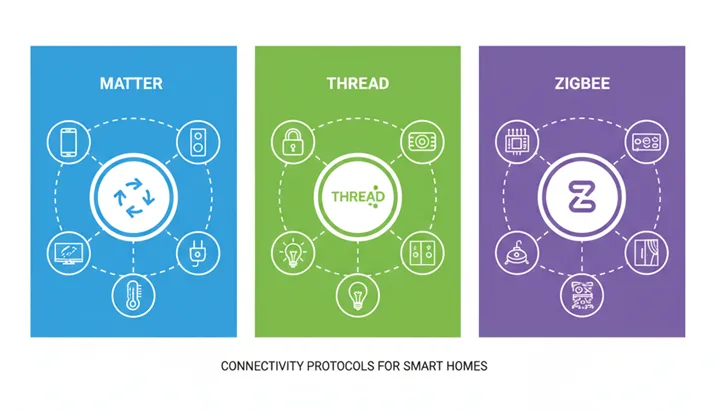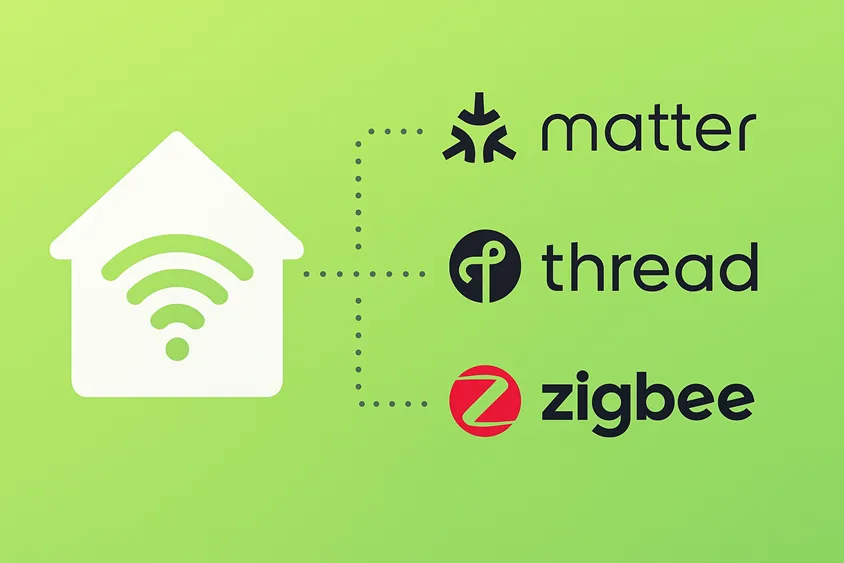If you’re a homeowner who’s curious about smart homes — not a technician, but someone who wants devices that work — you’ve probably seen the names Matter, Thread, and Zigbee on product pages and wondered which one to choose. Good news: you don’t need to memorize protocol stacks. Instead, learn a few practical rules so you buy devices that interoperate, respond fast, and don’t drain batteries.
What is Matter smart home standard? Matter is an application-level standard created by the Connectivity Standards Alliance (CSA). It defines how devices describe themselves, how they securely join your home network, and how they expose capabilities to apps and voice assistants. In short, Matter makes cross-brand compatibility realistic.
Thread is a low-power, IPv6-based mesh network built for battery sensors and reliable multi-hop routing. Learn more at the Thread Group. By contrast, Zigbee is a mature mesh protocol with a huge installed base of bulbs and sensors.
Major brands and hubs (Apple HomePod mini, Google Nest Hub, and many routers) are adding Thread border-router support, and Matter certification is becoming common. Therefore, if you choose Matter vs Thread vs Zigbee wisely, you’ll avoid app sprawl, eliminate bridge headaches, and reduce future upgrade costs.
Read more at Matter vs Zigbee vs Z-Wave: Which Smart Home Protocol Wins in 2025?

What is Matter?
Matter is the modern, vendor-neutral standard for smart home devices. It defines device models, secure commissioning (QR/NFC), and consistent behaviours across ecosystems. Because Matter is application-layer, it uses transports like Thread, Wi-Fi, or Ethernet to carry messages. Learn more via the Connectivity Standards Alliance – Matter overview.
Key user benefits
- Cross-brand compatibility (Apple, Google, and Amazon support Matter).
- Simplified setup (standardized QR/NFC onboarding).
- Local control options (less cloud dependency → faster & more private).
What is Thread?
Thread is a low-power IPv6 mesh network optimized for constrained devices (battery sensors, switches). Thread devices form a self-healing mesh, forwarding packets across hops, which improves reliability and coverage. See the Thread Group for technical details.
Key user benefits
- Excellent battery life for sensors.
- Robust multi-hop mesh (better coverage across floors).
- Works best with a Thread border router (e.g., HomePod mini, Nest Hub) to link to the rest of your network.
What is Zigbee?
Zigbee is a long-standing wireless mesh protocol used widely in smart lights, plugs, and sensors. While it shares the IEEE 802.15.4 radio with Thread, Zigbee historically used its own profiles and non-IP routing models..
Key user notes
- Large catalog of devices and an established ecosystem.
- Often requires a vendor hub/coordinator for cloud access or cross-brand control.
- Many legacy devices remain useful with a proper bridge.
How They Differ — At a Glance
| Feature | Matter | Thread | Zigbee |
| Network Layer/Role | Application-layer standard defining interoperability and security. (CSA Matter) | IP-based mesh transport (IPv6) used to carry Matter messages. (Thread Group) | Mesh protocol + device profiles on IEEE 802.15.4; non-IP legacy models. (CSA Zigbee) |
| Typical transport | Runs over Thread, Wi-Fi, Ethernet; uses Bluetooth for commissioning. | IEEE 802.15.4 at 2.4 GHz (low-power mesh). | IEEE 802.15.4 at 2.4 GHz (mesh) with vendor profiles. |
| Interoperability | High when Matter-certified. | Excellent for low-power devices; best when used with Matter. | Good within the Zigbee ecosystem; vendor fragmentation exists. |
| Power efficiency | Varies: low with Thread; higher with Wi-Fi. | Very low power — ideal for battery sensors. | Low for many devices; depends on implementation. |
| Hub / border router | Thread devices need a border router; Wi-Fi devices may not. | Needs border router(s) to connect to IP/internet. | Typically needs a coordinator/hub for bridging. |
| Latency & responsiveness | Quick; depends on underlying transport. | Low latency; reliable multi-hop routing. | Reasonable; may see hub translation delays. |
| Security | Strong model and certification process. | Secure (AES encryption, IPv6 features); benefits from Matter. | Secure, but legacy devices may have weaker implementations. |
| Ecosystem maturity | Rapidly growing adoption. | Growing — supported by major hub vendors. | Mature, large installed base. |
Current trends & two real examples
IKEA’s Timmerflotte (Matter-over-Thread)
IKEA has been observed registering a Thread-capable Matter sensor, signaling mainstream vendors shipping Thread hardware for low-cost sensors. This shows the retail furniture/DIY segment is moving to Matter+Thread, making affordable, interoperable sensors more common.
Hub evolution (SmartThings, HomePod mini, Nest Hub)
Leading hubs and router vendors are adding Thread border-router support. That means if you buy Thread devices, modern hubs will connect them to the rest of your home and to Matter controllers — improving real-world interoperability.
Step-by-step buying & migration plan
Step 1 — Inventory
List devices and note protocol labels: Zigbee, Wi-Fi, Matter, Thread.
Step 2 — Prioritize by need
- Battery sensors → Thread + Matter.
- Lots of bulbs now → keep Zigbee and bridge.
- Cross-platform control (Apple/Google/Alexa) → Matter priority.
Step 3 — Verify hub/border router
If choosing Thread devices, ensure you have a Thread border router (HomePod mini, Nest Hub, or compatible router).
Step 4 — Buy in phases
Keep existing Zigbee gear working via a bridge; replace critical devices with Matter-certified models over time.
Step 5 — Test local control
After setup, temporarily turn off your internet to confirm local automations continue. This ensures reliability and privacy.
Why does this help you buy?
Buying smart home devices without understanding standards leads to incompatible apps and wasted money. By choosing Matter-certified products that also support Thread for battery devices, you can avoid buying new devices in the future, have quicker local control, and make your smart home automations easier. So when you pick products that are labeled Matter instead of Thread or Wi-Fi, you’re making a smart choice for a future-ready and adaptable smart home.
FAQs
Conclusion
Choosing between Matter, Thread, and Zigbee isn’t about picking a single “winner.” Rather, it’s about matching standards to use cases. Matter gives you consistent cross-brand compatibility and simplified onboarding; Thread gives battery devices long life and a resilient mesh; and Zigbee offers a vast catalog and proven reliability today. For most new buyers, the smartest approach is to prioritize Matter certification, and then prefer Thread where battery life and mesh reliability matter most. At the same time, there’s no need to discard an existing Zigbee ecosystem — use a bridge to integrate those devices into a Matter-based plan while upgrading strategically.
That means buying certified devices, confirming hub/border router compatibility, and migrating gradually rather than ripping and replacing. This method helps keep costs low, makes things simpler, and increases the chance that your devices will work well, stay safe, and connect for many years. In the long run, choosing wisely now—like picking Matter or Thread when it makes sense—is a small step that avoids wasting time, stress, and money later. It also delivers the user experience you want: a smart home that works reliably and grows with you.


